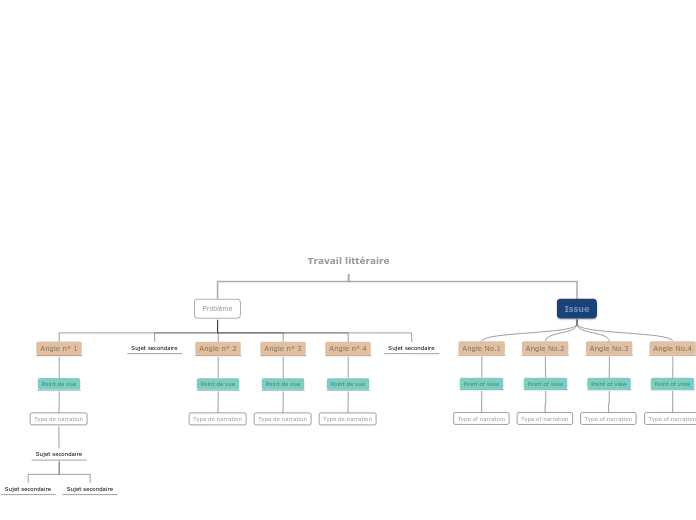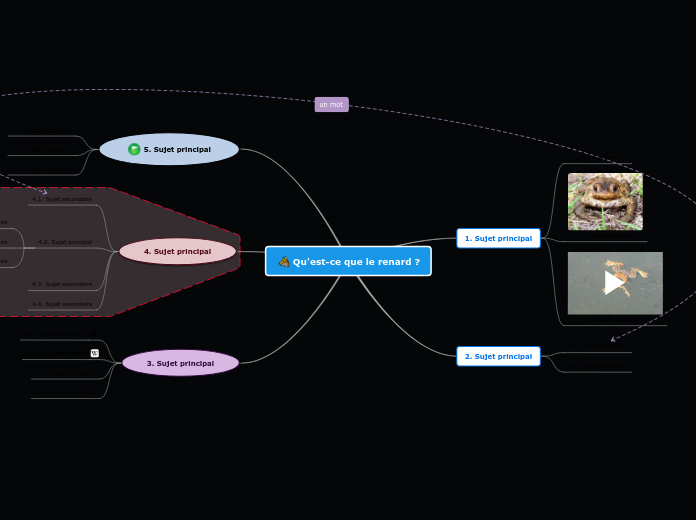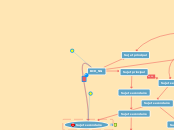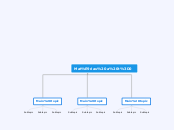Travail littéraire
Tapez le nom du texte à perspectives multiples.
Exemple: Bridge to Terabithia par Katherine Paterson
Issue
Identify an important issue from the text that is being presented from different angles. Type it in.
Example: Jesse's drawing talent.
Angle No.4
Decide on the fourth point of view
Type in the name of the last character whose perspective on the issue you are going to present.
Example: Leslie Burke, Jesse's new next-door neighbor, and best friend.
Point of view
Type in a relevant quote that highlights the character's point of view. Try to follow a citation format: author's name, chapter, and page.
Example: I can't get the poetry of the trees,' he said. She nodded. Don't worry,' she said. You will someday. He believed her.' (Paterson, 4. 24)
How is the viewpoint introduced in the story?
Choose an answer:
First person point of view - using the personal pronouns 'I' or 'we'Second person point of view - using the personal pronoun 'you'Third person point of view - using the third-person pronouns 'he', 'she' and 'they'Omniscient point of view - an all-seeing observer tells the story
Angle No.3
Whose character does the third point of view belong to?
Type in his/her name.
Example: Mr. Aarons, Jesse's father.
What does the character think, say or do that suggests their perspective on the issue?
Type in a quote and try to maintain the citation format.
Example: 'He would like to show his drawings to his dad, but he didn't dare. (...) He'd thought his dad would be pleased. He wasn't. What are they teaching in that damn school? he had asked.' (Paterson, 2.8)
What kind of narration introduces the viewpoint?
Choose an answer:
First person point of view - using the personal pronouns 'I' or 'we'Second person point of view - using the personal pronoun 'you'Third person point of view - using the third-person pronouns 'he', 'she' and 'they'Omniscient point of view - an all-seeing observer tells the story
Angle No.2
Decide on the second point of view
Name the character (it can either be the main character or one of the supporting characters) whose point of view you are presenting.
Example: Miss Edmunds, Jesse's music teacher.
Type in a quote that points out the character's position about the issue.
Try to follow a citation format: author's name, chapter, and page.
Example: 'She said he was unusually talented, and she hoped he wouldn't let anything discourage him.' (Paterson, 2. 8)
How is the viewpoint introduced in the story?
Choose an answer:
First person point of viewSecond person point of viewThird person point of viewOmniscient point of view
Angle No.1
Decide on the first point of view you are going to present.
Type in the name of the character (it can either be the main character or one of the supporting characters) whose point of view belongs to.
Example: Jesse Oliver Aarons, Jr., the main character of the novel, a fifth-grader living in a rural Southern area.
Point of view
Type in a relevant quote that highlights the character's point of view towards
Issue.
Try following a citation format: author's name, chapter, and page.
Example: 'Jesse drew the way some people drank whiskey. (...) Lord, he loved to draw. (...) When he was in first grade, he told his father that he wanted to be an artist when he grew up.' (Paterson, 2. 7)
Type of narration
What type of narration introduces the viewpoint?
Choose an answer:
First person point of view - using the personal pronouns 'I' or 'we'Second person point of view - using the personal pronoun 'you'Third person point of view - using the third-person pronouns 'he', 'she' and 'they'Omniscient point of view - an all-seeing observer tells the story
Problème
Identifiez un problème important dans le texte qui est présenté sous différents angles. Tapez-le.
Exemple: Le talent de dessin de Jesse.
Angle n° 4
Décidez sur le quatrième point de vue.
Tapez le nom du dernier personnage dont vous allez présenter le point de vue sur le problème.
Exemple: Leslie Burke, la nouvelle voisine de Jesse et meilleure amie.
Point of view
Type in a relevant quote that highlights the character's point of view.
Essayez de suivre un format de citation: nom de l'auteur, chapitre et page.
Example: I can't get the poetry of the trees,' he said. She nodded. Don't worry,' she said. You will someday. He believed her.' (Paterson, 4. 24)
Angle n° 3
À quel personnage appartient le troisième point de vue?
Tapez son nom.
Exemple: M. Aarons, le père de Jesse.
Qu'est-ce que le personnage pense, dit ou fait qui suggère son point de vue sur la question?
Essayez de suivre un format de citation: nom de l'auteur, chapitre et page.
Exemple: 'He would like to show his drawings to his dad, but he didn't dare. (...) He'd thought his dad would be pleased. He wasn't. What are they teaching in that damn school? he had asked.' (Paterson, 2.8)
Angle n° 2
Décidez le deuxième point de vue.
Nommez le personnage (il peut s'agir du personnage principal ou de l'un des personnages secondaires) dont vous présentez le point de vue.
Exemple: Mlle Edmunds, professeur de musique de Jesse.
Tapez une citation qui souligne la position du personnage sur le problème.
Essayez de suivre un format de citation: nom de l'auteur, chapitre et page.
Exemple: 'She said he was unusually talented, and she hoped he wouldn't let anything discourage him.' (Paterson, 2. 8)
Comment le point de vue est-il introduit dans l'histoire?
Choisissez une réponse:
Point de vue à la première personnePoint de vue à la deuxième personnePoint de vue à la troisième personnePoint de vue omniscient
Angle n° 1
Décidez du premier point de vue que vous allez présenter.
Tapez le nom du personnage (il peut s'agir du personnage principal ou de l'un des personnages secondaires) dont le point de vue appartient.
Exemple: Jesse Oliver Aarons, Jr., le personnage principal du roman, un élève de cinquième année vivant dans une zone rurale du Sud.
Point de vue
Tapez une citation pertinente qui met en évidence le point de vue du personnage vers
Problème.
Essayez de suivre un format de citation: nom de l'auteur, chapitre et page.
Exemple: 'Jesse drew the way some people drank whiskey. (...) Lord, he loved to draw. (...) When he was in first grade, he told his father that he wanted to be an artist when he grew up.' (Paterson, 2. 7)
Type de narration
Quel type de narration introduit le point de vue?
Choisissez une réponse:
Point de vue à la première personne - en utilisant les pronoms personnels «je» ou «nous»Point de vue de la deuxième personne - utiliser le pronom personnel 'vous'Point de vue de la troisième personne - en utilisant les pronoms à la troisième personne «il», «elle» et «ils»Point de vue omniscient - un observateur qui voit tout raconte l'histoire
Sujet secondaire









